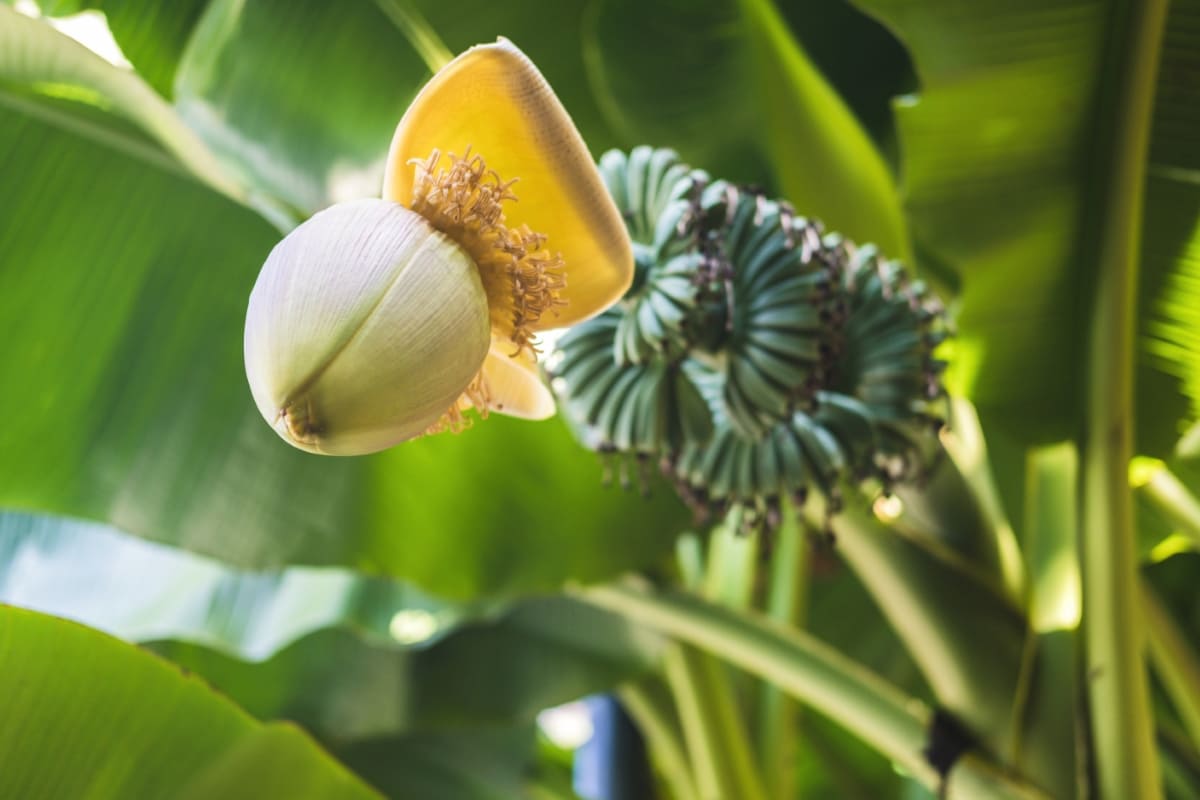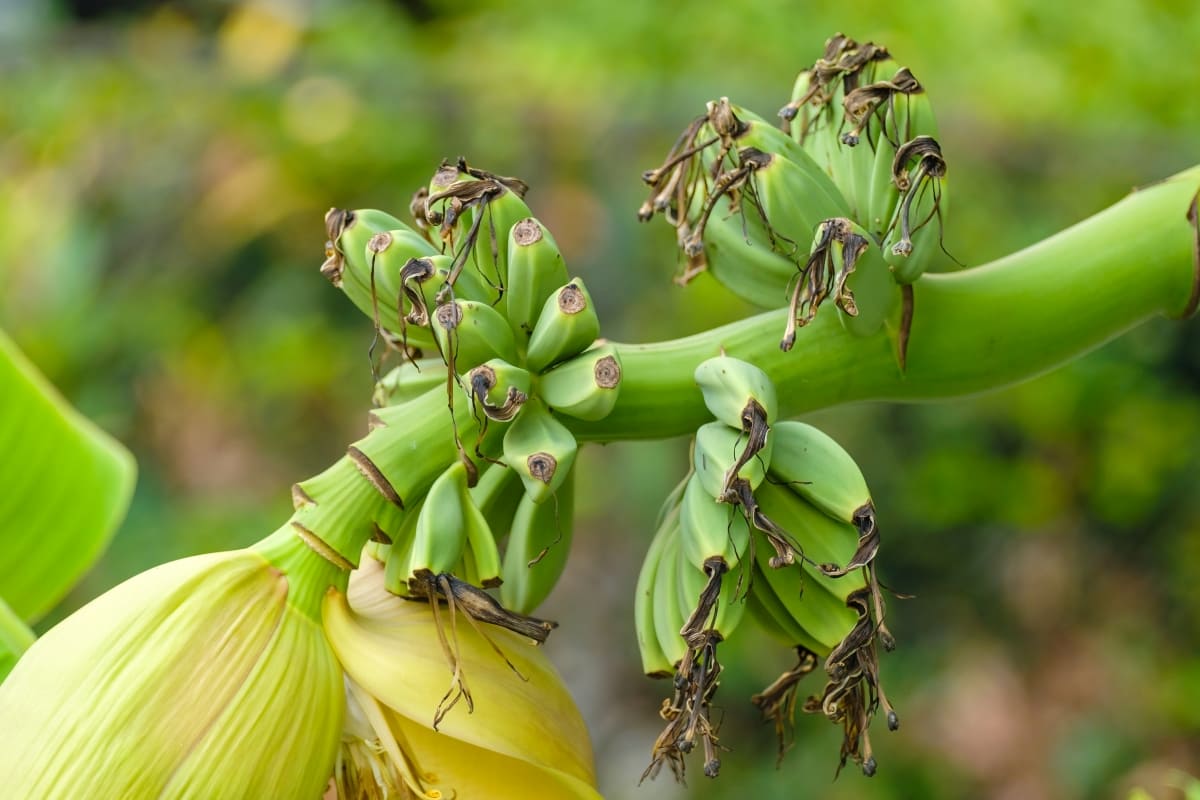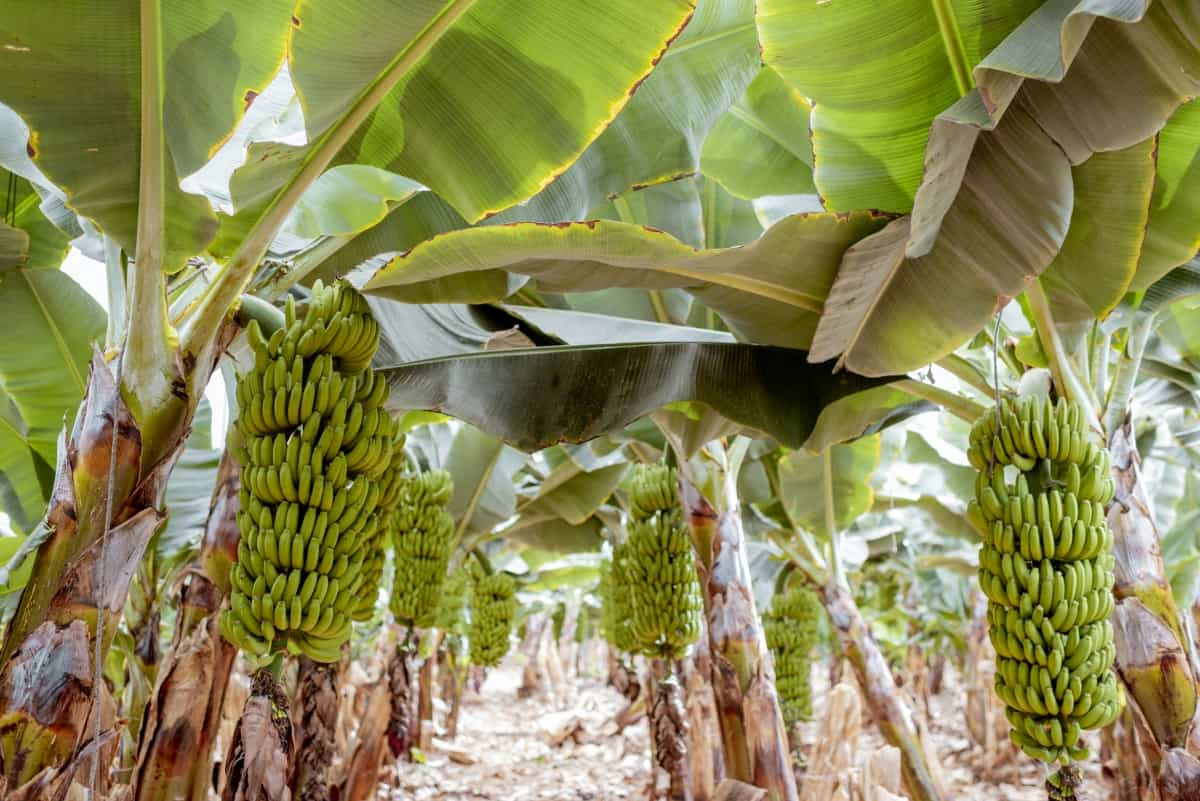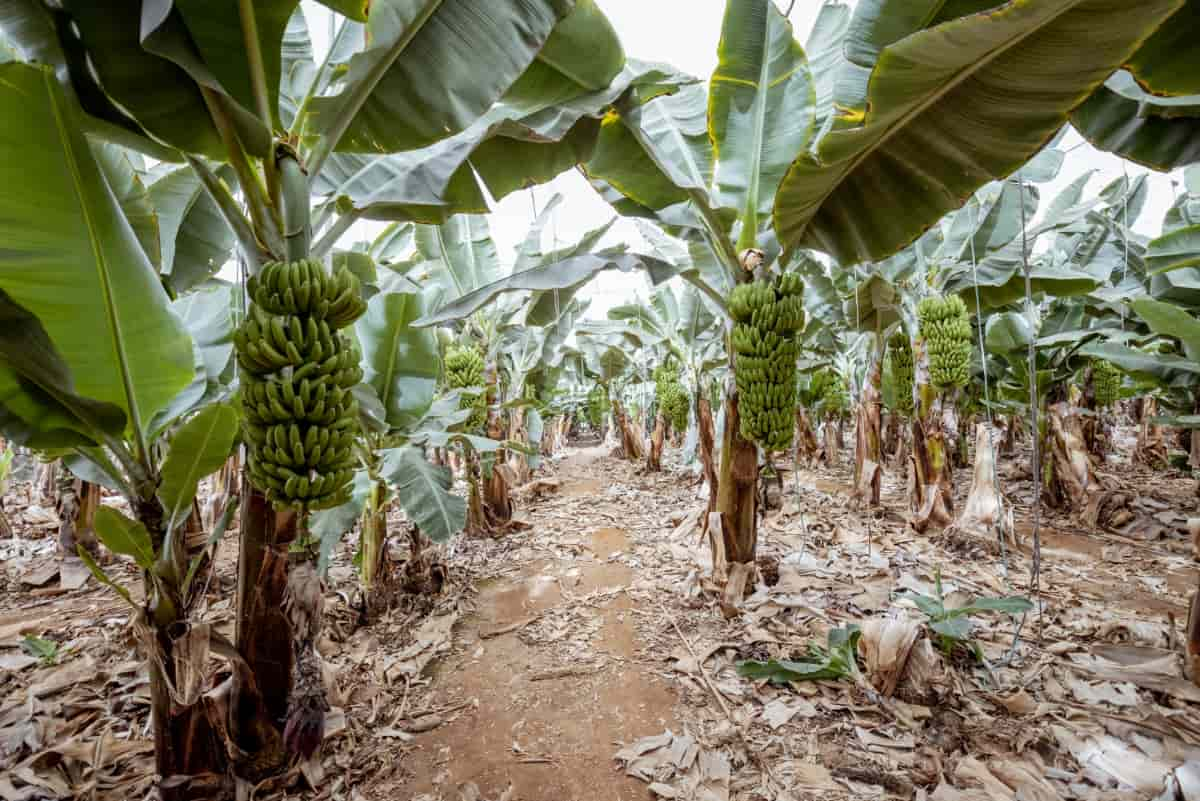The banana plant’s susceptibility to flower and fruit drops can be a significant challenge for growers. When flowers or young fruit fall prematurely from the plant, it results in reduced yields and, ultimately, economic losses. Stopping flower drops and fruit drops in banana plants is essential for maximizing fruit production and yield. Flower drops and fruit drops can occur due to various factors, including environmental conditions, pests, and disease. In this guide, we will briefly explore some strategies and methods to prevent flower and fruit drops in banana plants.

How to Stop Flower Drop and Fruit Drop in Banana
Causes of Flower Drop and Fruit Drop in Banana Plants
Flowers and fruit drop in banana plants can result from various factors. Abiotic factors, such as adverse weather conditions like extreme temperatures, strong winds, and excessive rainfall, can disrupt pollination and affect fruit development. Additionally, inadequate nutrient supply, particularly potassium deficiency, can lead to flower and fruit drop.
- Biological factors like pests, diseases, and poor soil health can also contribute to the problem. Infections like Panama disease and pest infestations such as nematodes can harm the plant, causing it to shed flowers and fruits.
- Cultural practices, such as improper irrigation, excessive fertilization, or overcrowding, may stress the plant and result in flower and fruit drop. Inadequate pollination, often due to insufficient pollinator presence, can also be a key factor.
- Proper care, including balanced fertilization, pest and disease management, and favorable environmental conditions, can help mitigate these issues and improve banana yield.
Proper Watering Techniques to Prevent Flower and Fruit Drops in Bananas
- Consistent Moisture: Maintain even soil moisture by providing a regular water supply. Avoid the soil to dry out completely between watering.
- Deep Watering: Water deeply to ensure moisture reaches the root zone. Shallow watering leads to shallow root development and increased susceptibility to stress.
- Mulching: Apply mulch around the plant’s base to retain soil moisture, regulate temperature, and reduce evaporation.
- Avoid Waterlogging: Ensure good drainage to prevent waterlogged soil, which causes root rot and other issues. Planting bananas in well-draining soil is essential.
- Early Morning Watering: Water in the morning to allow foliage to dry before evening, reducing the risk of fungal diseases.
Optimal Nutrient Levels for Minimizing Flower and Fruit Drops
- Nitrogen (N): Provide moderate nitrogen to support healthy vegetative growth but avoid excessive nitrogen, which can lead to excessive leafy growth and reduce fruit production.
- Potassium (K): Ensure an ample supply of potassium, which is essential for flower and fruit development. A deficiency can result in fruit drop.
- Phosphorus (P): Adequate phosphorus is necessary for root development and fruit production.
- Calcium (Ca) and Magnesium (Mg): Maintain sufficient levels of these secondary nutrients to prevent flower and fruit drop due to deficiencies.
- Micronutrients: Monitor and supplement with micronutrients like boron, zinc, and copper, as deficiencies can also impact fruit retention.
In case you missed it: Harvesting and Post-Harvest Handling of Bananas: From Picking to Market

Controlling Pests and Diseases to Reduce Flower and Fruit Drops in Banana Trees
- Integrated Pest Management (IPM): Implement IPM strategies to monitor and control pest populations. Use natural predators, traps, and selective pesticides when necessary to minimize damage.
- Fungicide Application: Apply fungicides to prevent and manage diseases like Panama disease, Sigatoka, and anthracnose.
- Sanitation: Remove infected plant material to prevent disease spread.
- Quarantine: Isolate new plantings to prevent introducing pests or diseases to your existing banana grove.
- Proper Pruning: Prune and remove affected leaves and pseudostems to reduce disease reservoirs.
- Regular Inspection: Monitor plants for early signs of pest or disease infestations to take prompt action.
Environmental Factors to Prevent Flower and Fruit Drops in Banana Crops
- Firstly, maintaining consistent soil moisture is essential. Adequate irrigation practices, such as drip irrigation or mulching, can help regulate moisture levels, preventing stress-induced drops.
- Secondly, controlling temperature and humidity is vital. Bananas thrive in warm, tropical climates, but extreme temperatures or sudden fluctuations can lead to flower and fruit drops. Providing shade or using misting systems can help mitigate these effects.
- Furthermore, wind protection is crucial. Strong winds can physically damage flowers and young fruits, leading to drops. Windbreaks, such as hedgerows or artificial barriers, can shield the crop from excessive wind exposure.
- Lastly, proper nutrient management is essential. Ensuring the soil has balanced levels of essential nutrients, particularly potassium, can promote healthy flower and fruit development, reducing drop rates.
Pruning Techniques to Enhance Fruit Set and Minimize Flower Drops in Banana Plants
- Temperature: Maintain a consistent and favorable temperature range (around 28-30°C) during the growing season to ensure proper flower and fruit development.
- Humidity: Maintain adequate humidity levels, as low humidity can impair pollination and fruit set.
- Wind Protection: Shield banana plants from strong winds, which can damage flowers and young fruit, leading to drop.
- Light: Provide sufficient sunlight for photosynthesis and fruit development, but avoid excessive exposure to scorching sun.
- Shade: In some regions, providing partial shade can protect plants from excessive heat and wind.
In case you missed it: How Drip Irrigation in Banana Plantations Will Increase Fruit Size and Yields

Protecting Banana Plants from Extreme Temperatures to Prevent Flower and Fruit Drops
- Mulching: Add organic mulch around the base of the plant to regulate soil temperature and protect roots from temperature fluctuations.
- Windbreaks: Erect windbreaks or barriers to shield plants from strong winds, which can damage flowers and fruits.
- Shade Cloth: Use shade cloth during excessively hot periods to reduce sun exposure and prevent scorching of leaves and fruits.
- Irrigation: Maintain consistent soil moisture through proper watering, as well-moisturized soil can better withstand temperature extremes.
Identifying Hormonal Imbalances to Reduce Flower and Fruit Drops in Bananas
To reduce flower and fruit drops in banana plants, it’s crucial to identify and address potential hormonal imbalances. Hormonal imbalances in banana plants can disrupt their reproductive and fruit-setting processes. Monitor the banana plants for signs of stress, nutrient deficiencies, or disease, as these can affect hormone levels.
- Gibberellins: High levels of gibberellins can lead to excessive vegetative growth and flower drop. Prune excess foliage and provide balanced nutrition to regulate gibberellin levels.
- Auxins: Adequate auxin levels are essential for proper fruit development. Ensure proper nutrition, as deficiencies can disrupt auxin balance.
- Ethylene: Ethylene can induce premature fruit ripening and drop. Avoid storing ripening fruits near the banana plants and maintain good airflow.
- Abscisic Acid: High abscisic acid levels can lead to flower drop. Avoid water stress and maintain consistent soil moisture to manage this.
Proper Harvesting Practices to Minimize Flower and Fruit Drops in Banana Crops
- Harvest at the Right Stage: To reduce premature fruit drop, wait until bananas are fully mature but firm before harvesting. Use Sharp Tools: Employ sharp knives or shears to cut fruit clusters, minimizing damage to the plant.
- Handle Carefully: Avoid rough handling to prevent physical damage to the plant and fruit.
- Remove Suckers Timely: Regularly eliminate excess suckers to direct plant energy towards fruit development.
- Maintain Hygiene: Prevent contamination by maintaining clean harvesting tools and sanitation practices.
In case you missed it: Different Methods of Banana Propagation: Exploring Various Techniques

Conclusion
In conclusion, preventing flower and fruit drops in banana plants requires a holistic approach. By addressing these factors with care and diligence, growers can promote healthier and more fruitful banana plants, ultimately increasing yields and the sustainability of banana cultivation.
- Feed Your Flock for Less: Top 10 Tips to Save on Chicken Feed
- Ultimate Guide to Ossabaw Island Hog: Breeding, Raising, Diet, and Care
- Hatching Answers: The Top 10 Reasons Your Chickens Aren’t Laying Eggs
- Eggs and Economics: Breaking Down the Cost of Raising Backyard Chickens
- Defend Your Greens: Proven Methods to Keep Iguanas Out of Your Garden
- Ultimate Guide to Cinnamon Queen Chicken: A Comprehensive Guide for Beginners
- Ultimate Guide to California Tan Chicken: Breeding, Raising, Diet, Egg-Production and Care
- Ultimate Guide to Marsh Daisy Chicken: Breeding, Raising, Diet, and Care
- 10 Types of Chicken Farming Businesses You Can Start for Profits